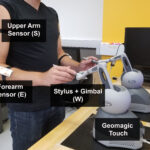Our research centers on robotics, haptics, teleoperation, and human-centric modeling, applied to problems in surgical and medical intervention and training.
Surgical Robotics
Our long-term goal is to develop robotic systems that are truly collaborative partners with surgeon operators. We develop highly specialized robotic systems such as for needle steering, or develop novel control techniques for existing robots, such as the da Vinci Surgical System.
Human-Centered Modeling
A critical aspect of developing assistive robots that interact physically with humans is to ensure that the robotic system understands what the human intends to do and how well they are doing it. Our lab has developed a variety of tools to describe human behavior or human experiences in language understandable by the robotics system, including modeling bimanual coordination, movement style, and task difficulty.
Haptics for Movement Guidance and Training
Sometime, rather than building a robot to do something, it might be more effective to instead find better ways to guide the human operator. Here, the human arm mechanism is perfectly capable of achieving some task, but perhaps they need a little help with figuring out what they should do. We are developing novel techniques to guide human movement, particularly when mediated through some type of surgical tool.
Technologies for Surgical Education and Assessment
We have developed custom haptic devices for training surgical skills such as trocar insertion, using a ureteroscope, and holding surgical instruments. We have also developed data-driven methods to assess surgical expertise and mastery.
Haptic Rendering
Haptic rendering is a technology that simulates the sense of touch or tactile feedback in virtual environments. In the context of surgical simulation, haptic rendering plays a crucial role in providing realistic tactile sensations to surgeons during training and practice. By integrating force feedback devices and 3D models of anatomical structures, haptic rendering allows surgeons to feel the resistance, texture, and stiffness of tissues, instruments, and organs in a simulated surgical environment. This technology is invaluable in surgical training programs, enabling aspiring surgeons to develop their skills and improve their dexterity while minimizing the risk to real patients. Furthermore, haptic-enabled surgical simulation also finds applications in preoperative planning, allowing surgeons to rehearse complex procedures and evaluate potential challenges, ultimately contributing to safer and more precise surgical outcomes.


